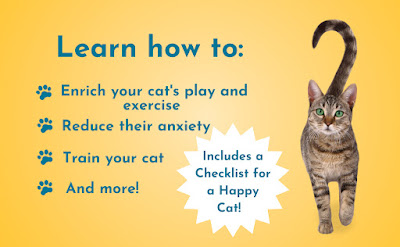3 Easy Ways to Get Started with Training Your Cat
 |
| Photo: Veronika Zelenina/Shutterstock |
By Zazie Todd PhD
Get Companion Animal Psychology in your inbox.
Training Your Cat: Benefits and Easy Techniques to Begin
If you’ve never trained one of your pets before, it can feel a bit intimidating to get started. Especially when your pet is a cat. But the good news is that despite the stereotypes, an increasing number of people are realizing that cats can be trained—and it’s fun for you and the cat.
This article will look at why we should train our cats, as well as 3 easy ways to get started.
The benefits of training cats
Training can have several benefits for cats. Training cats does not necessarily mean teaching them tricks—although it can do, because it can be a fun enrichment activity for you and your cat.
More often, the training we do with our cats is aimed at helping the cat in their everyday life. This is especially the case with training cats to go in their cat carrier, because so many cats run to hide as soon as they see their carrier come out, but it’s necessary for them to go to the vet. In fact, research shows that vet visits are easier when cats are trained to go in their carrier. Not only is it easier to get them to the vet in the first place, but the vet is more likely to be able to complete the exam as well.
It’s even possible to train cats for veterinary procedures and medication. For example, a couple of years ago International Cat Care developed some videos that explain how to teach a cat to use an asthma inhaler.
The process of training with positive reinforcement can be good for cats in itself, even if you don’t have any wider aims. One study found that when cats are frustrated in a shelter, training can help improve their health as well as make them more contented. As well, any cat can be trained, as was the finding of another study with shelter cats where even the shyest and most senior cats were able to learn some new tricks.
So how do you train a cat?
The best way to train a cat is with little pieces of tasty treats or food as positive reinforcement. You can find some tips on choosing cat training treats here.
There may be some cases when using play or brushing will work as positive reinforcement too, although that very much depends on the cat as some hate to be brushed, in which case you would be punishing them instead and we don’t want that.
Some people like to use a clicker, meaning that they click at the exact moment when the cat does the behaviour that’s wanted and then give a treat after the click. There are times when using a clicker is very helpful, but it isn’t needed for the activities below. One small study found that training progressed better when the cat was rewarded with food only compared to if they heard a beep before the food or if they were not given any food at all. (Of course, you can’t expect your cat to work for nothing, hence the need for treats!).
For the 3 activities below, you’ll need to pick a food treat that you are going to use.
Then find somewhere to stash it where it will be easy to get just at the moment when you need it. Maybe in a cupboard or in a jar on a countertop or bookshelf.
3 easy ways to start training your cat
If you want to try training your cat, here are 3 easy ways to get started that you can fit into your everyday interactions with your cat. Pick the one that appeals to you most and give it a go.
1) Teach your cat to come when called
When people try to claim that cats can’t be trained, I ask if they’ve ever known a cat come running at the sound of a treat packet rustling or a tin can being opened, because then the cat has shown they’ve learned that the sound predicts something nice and tasty for them.
For this activity, you should pick a word that you will use as your recall cue. Although it could be the cat’s name, there are likely many situations in which you use their name. As well, they probably already know it (as well as the names of other pets in the house).
So pick a word that you will just use when you want your cat to come when called. “Here, kitty!”, “Come”, “Treats!”, and “Come here,” are all options, but pick something that you like and that will be unique to this situation.
You want to make sure that you use this recall cue before anything starts to happen with treats.
So make sure your cat is in earshot, say your recall cue, then go to get the treats from the place you’ve stashed them, then go looking for your cat and give them a treat.
Hang on a minute, isn’t the cat supposed to come to you? Yes, but in the beginning they don’t know that the recall cue means anything. It’s up to you to teach them that when they hear the recall cue, it means they are going to get a yummy treat.
If your cat already comes for the sound of the treat packet, you’ve got a head start. They will soon learn that the cue means you’re going to get the treats out, and start coming for the cue instead of waiting for the rustle of the packet.
But even if your cat so far doesn’t come for anything, they will learn that the cue means you’ll get the treats.
Over time, you can start to make your cat come a very short distance for the treat and then build up from there. But since this post is just about easy ways to get started, for now we’ll stop here.
Remember, the treats should be stashed away in advance, and the sequence is that you say “Here kitty!” (or whatever your recall cue is), get the treats, give a treat to your cat.
Make sure that every single time you say the recall cue, your cat gets a food reward. Practice a few times a day at random times.
2) Cat carrier training baby steps
Depending on your cat’s current comfort level with their cat carrier, this one may be a little more difficult, so we’re going to make it super easy for you and your cat and start at a very basic level. But there’s a very important rule for this training exercise: You aren’t going to shut your cat in the carrier.
Let’s assume the cat carrier lives in a cupboard and only comes out when you go to the vet. Get it out of the cupboard and clean it to make sure it doesn’t have any scents of the vet on it or of times when your cat was scared.
Then find a nice blanket or fluffy towel to put in the bottom, so that it becomes a space that could be a cozy hiding place for your cat.
Put the cat carrier in a room that you often use. Don’t put it down in the middle of the room—pick somewhere that is not in your way and where the cat might like to be. This could be on the edge of the room or next to a sofa, maybe.
Then pick the place where you’re going to put treats. Did your cat run and hide when they saw you doing something with the carrier? If so, you could put the treats near the entrance to the room. Was your cat not really bothered by the sight of the carrier? If so, you could put the treats close to the carrier, maybe a foot away. Or if they are really brave, put them right at the entrance to the carrier.
About 3-5 times a day, at random times, go and get a treat and put it in that place. Your cat can come and eat it when they like.
Remember, you aren’t going to shut the cat in the carrier even if they go all the way in. They get a treat simply for going close to it, where “close” is defined as a distance where your cat feels safe, even if that’s out in the hallway by the entrance to the room.
Of course, one day you will want to shut your cat in the carrier and take them to the vet. If you’d like to do this training, you’ll find a plan at the back of my book Purr: The Science of Making Your Cat Happy.
3) Using the scratch post
Scratching is a natural behaviour for cats, which means we can’t expect them not to do it—scratching keeps their claws in good condition, gives the cat a full-body stretch, and deposits pheromones from the pads in the paws.
Hopefully you already have a good scratching post which is nice and tall and also sturdy. Research shows that cats will use a scratching post if one is available, and also are more likely to use it if they are reinforced for doing so.
What you are going to do for this training exercise is wait until your cat happens to use the scratching post, keep still and quiet while they use it—and as soon as they’ve finished, give them a treat.
This is a training technique called capturing, because you’re waiting for a behaviour that your cat will do anyway, and then using positive reinforcement in the form of a treat to make it more likely they will do it again.
You will need to have the treats stashed somewhere handy so that you can be quick in giving the treat to your cat as soon as they have finished using the post. You don’t want to give it earlier—or do anything that suggests you’re about to give it—because you don’t want to interrupt the cat in their scratching.
If you wanted, you could also take a moment to check your cat’s scratching post(s) to ensure you and your cat are happy about them. Bear in mind that individual cats have preferences for the type of material (although most are happy with a sisal post), and some cats like to have a horizontal scratching post too.
Once you’ve tried one of these activities for a while, you can add in one of the other ones. Hopefully you and your cat will enjoy these 3 easy training activities. Let me know how you get on!
If you liked this post, check out my book Purr: The Science of Making Your Cat Happy. Modern Cat magazine calls it “a must-have guide to improving your cat’s life.”
 |
| Get Purr: The Science of Making Your Cat Happy |

Offered by our Wellcare World friend at
Trending Also -> Physiotherapy Terahertz Technology TeraMD
Wellcare World specializes in providing the latest advancements in wellness technology, supplementation, and lifestyle changes that improve health and increase the quality of people's lives. To learn more, visit WellcareWorld.com and begin living a better life today.
Share Us With Others





